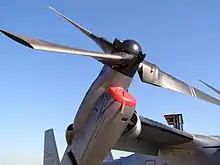Proprotor
A proprotor is a spinning airfoil that function as both an airplane-style propeller and a helicopter-style rotor. Several proprotor-equipped convertiplanes, such as the Bell Boeing V-22 Osprey tiltrotor, are capable of switching back and forth between flying akin to both helicopters and fixed-wing aircraft.[1] Accordingly this type of airfoil has been predominantly applied to vertical takeoff and landing (VTOL) aircraft.

The dual-role airfoil is accomplished by one of several design approaches:
- changing the angle of attack of the wing that the proprotor is attached to, from approximately zero degrees to around ninety degrees: a tiltwing aircraft,
- changing the angle of attack of only the rotor hub, and possibly the engine that drives it, as on a tiltrotor,
- changing the angle of attack of the entire aircraft, as on a tailsitter, which launches and lands on its tail.[2]
Application details
On several aerial vehicles such as the AgustaWestland AW609 and V-22 Osprey, a pair of three-bladed proprotors have been used.[3] Both the proprotors and engines are mounted on load-bearing rotatable pylon at the wingtips, allowing the proprotors to be positioned at various angles. In the case of the AW609's, while flown in helicopter mode, the proprotors can be positioned between a 75- and 95-degree angle from the horizontal, with 87 degrees being the typical selection for hovering vertically;[4] and in airplane mode, the proprotors are rotated forward and locked in position at a zero-degree angle, spinning at 84% RPM.[5] STOL rolling-takeoff and landing capability is achieved by having the nacelles tilted forward up to 45°.[6][7]
Typically, flight control software would perform much of the complex transition between the distinct helicopter and airplane modes;[5] while automated systems are usually provided to inform crews on the optimal tilt angle and air speed to pursue.[4] Furthermore, it is typical for flight controls, such as blade pitch, to both resemble and function akin to their counterparts on conventional rotorcraft, easing the transition of conventional helicopter pilots to such vehicles.[5][4]
Proprotors can be designed to fold for storage purposes.[8] However, in the case of the V-22, in order to facilitate proprotor folding, the proprotor's diameter had to be constrained to a diameter of 38-foot (11.6 m), five feet (1.5 m) less than optimal for vertical takeoff; this difference has been attributed for causing relatively high disk loading.[9]
In a typical implementation, both proprotors must be rotating in order to maintain flight in helicopter mode. To guard against instances of single engine failure, on both the V-22 and AW609, both engines are connected by drive shafts to a common central gearbox so that one engine can power both proprotors if such a failure occurs.[10] Despite this provision, the V-22 is generally not capable of hovering on a single engine.[11] If a proprotor gearbox fails, that proprotor cannot be feathered, and both engines must be stopped prior to an emergency landing. The autorotation characteristics are poor partly due to the rotors' low inertia.[12]
Aircraft
References
Citations
- "Bell Boeing V-22 Osprey". navair.navy.mil. Retrieved 20 June 2020.
- Rao, Smriti (20 January 2010). "Meet the "Puffin," NASA's One-Man Electric Plane". Discover Magazine.
- Croft, John. "Tilters." Archived 2008-07-25 at the Wayback Machine Alternate linkAir & Space/Smithsonian, 1 September 2007. Accessed on 6 May 2015.
- Stephens, Ernie (1 December 2014). "The AW609 Tilt Rotor: 2014's Best Ride". Aviation Today. Archived from the original on 2 December 2014. Retrieved 1 December 2014.
- Head, Elan (20 January 2014). "Flying the AW609: A Preview". Vertical. Retrieved 20 January 2014.
- "V-22 Osprey Guidebook, 2013/2014." Archived October 20, 2014, at the Wayback Machine Bell-Boeing, 2013. Retrieved: 6 February 2014. Archived in 2014.
- Chavanne, Bettina H. "USMC V-22 Osprey Finds Groove In Afghanistan." Aviation Week, 12 January 2010. Retrieved: 23 June 2010.
- Currie, Major Tom P., Jr., USAF. "A Research Report Submitted to the Faculty, In Partial Fulfillment of the Graduation Requirements: The CV-22 'Osprey' and the Impact on Air Force Combat Search and Rescue" (PDF). Archived 2016-03-06 at the Wayback Machine Air Command and Staff College, April 1999.
- Whittle, Richard. "Flying The Osprey Is Not Dangerous, Just Different: Veteran Pilots Archived 2012-09-14 at the Wayback Machine" defense.aol.com, 5 September 2012. Retrieved: 16 September 2012. Archived on 3 October 2013.
- Norton 2004, pp. 98–99.
- Whittle, Richard. "Fatal Crash Prompts Marines To Change Osprey Flight Rules Archived 2015-07-19 at the Wayback Machine". Breaking Defense, 16 July 2015.
- McKinney, Mike. "Flying the V-22" Vertical (magazine), 28 March 2012. Archived on 30 April 2014.
Bibliography
- Norton, Bill. Bell Boeing V-22 Osprey, Tiltrotor Tactical Transport. Earl Shilton, Leicester, UK: Midland Publishing, 2004. ISBN 1-85780-165-2.
- Whittle, Richard. The Dream Machine: The Untold History of the Notorious V-22 Osprey. New York: Simon & Schuster, 2010. ISBN 1-4165-6295-8.